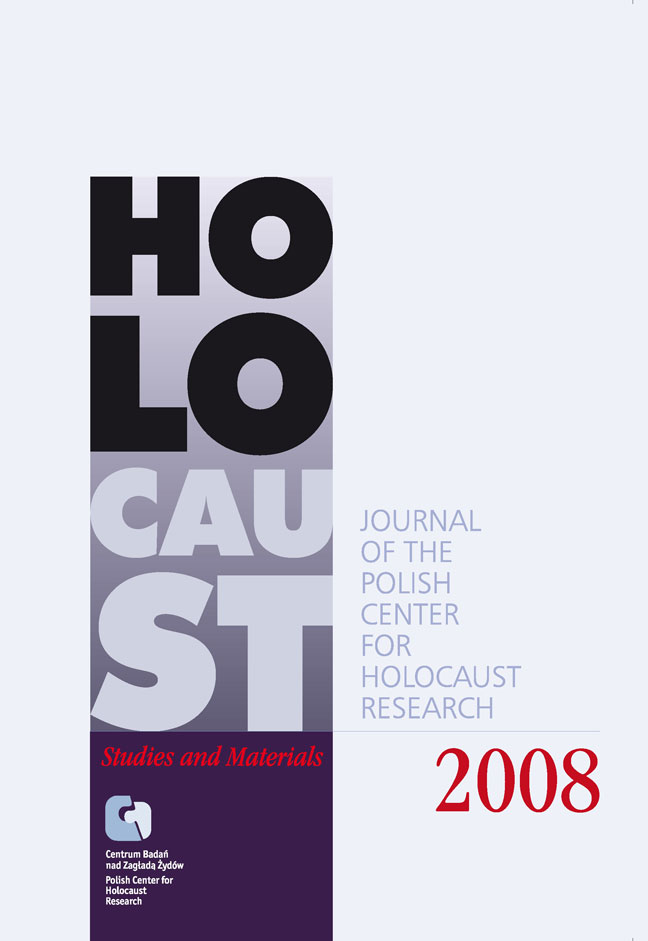Understanding the Holocaust. A Task for Generations
Zagłada Żydów. Studia i Materiały, 2008, Strony: 11-20
Data zgłoszenia: 2020-09-25Data publikacji: 2008-12-01
 https://doi.org/10.32927/ZZSiM.58
https://doi.org/10.32927/ZZSiM.58
Abstrakt
The Holocaust destroyed virtually the entire Jewish community in Poland. Zusman Segałowicz, the pre-war chairman of the Jewish Union of Writers and Journalists of 13 Tłomackie Street, Warsaw, managed to leave Warsaw in 1939 and via Vilna, Kaunas, Bulgaria, Turkey, and Syria reached Palestine, where, under the beating Tel-Aviv sun, he pondered on the burning ruins of the ghetto. His memoirs, published in 1946 in Argentina (the author died in New York in 1949), contain the following passage: I pass conflagration sites. I dig in the ashes. For the time being, these are the ashes of 13 Tłomackie St. All that is left of the entire Jewish world in Poland is a cemetery. Sometimes our pain leads us to divide this great cemetery into individual, smaller cemeteries: the cemetery of the Hassidic world, the cemetery of Jewish workers, merchants, entrepreneurs and industrialists, the cemetery of Jewish children who were to be our future. Finally, our thoughts run toward the cemetery of the Jewish spirit: the theatre, music, art, journalism and literature. We cannot depart from any of these cemeteries, but, at the same time, we should not come too close, for it could drag one into its endless abyss. What are we to do then? Shout? The dead won't hear us, and the world of the living is more dead than the world of the dead.
The Holocaust happened on our soil, in full view of Polish society, and it is an integral part – whether one wants it or not – of Polish history. For the Poles, the experience of the Holocaust remains a unique event and carries extraordinary responsibilities. Nevertheless, in terms of social awareness, the Shoah seems to belong to Jewish rather than to Polish history. Even today many Poles feel ill at ease, threatened or outright disappointed by the Jewish perceptions of the Holocaust and oftentimes the Jews are seen as rivals in the martyrology competition. Despite the recent historical research and public debates, culminating with the discussion around the Jedwabne crime, Polish society largely ignores the issues related to the Holocaust. Still too many myths and lies find their way to the public sphere and enter public circulation. This state of affairs is related, to a certain extent, to the sad legacy of decades of censorship and neglect under the communist rule. We believe that this should change. This is why we shall link research with educational activities in order to foster the knowledge of issues related to the Holocaust.
Słowa kluczowe
Zagłada , metodologia historii , pamiętniki , dzienniki , relacje
Licencja
Prawa autorskie (c) 2008 Autor&"Zagłada Żydów. Studia i Materiały"

Utwór dostępny jest na licencji Creative Commons Uznanie autorstwa 4.0 Międzynarodowe.
https://creativecommons.org/licenses/by/4.0
Czasopismo publikowane jest w standardzie Diamond Open Access na licencji CC-BY-4.0 Deed - Uznanie autorstwa 4.0 Międzynarodowa - Creative Commons
Inne teksty tego samego autora
- Jacek Leociak, Rachel Brenner, The Ethics of Witnessing. The Holocaust in Polish Writers’ Diaries from Warsaw, 1939–1945 , Zagłada Żydów. Studia i Materiały: Nr 11 (2015)
- Jacek Leociak, Geographies of the Holocaust, red. Anne Kelly Knowles, Tim Cole, Alberto Giordano, Bloomington–Indianapolis: Indiana University Press, 2014, 260 s. , Zagłada Żydów. Studia i Materiały: Nr 14 (2018)
- Jacek Leociak, Michał Głowiński , Zagłada Żydów. Studia i Materiały: Nr 19 (2023)
- Jacek Leociak, Miriam Akawia, Haderech ha’acheret , Zagłada Żydów. Studia i Materiały: Nr 3 (2007)
Podobne artykuły
- Dan Michman, Społeczeństwo holenderskie i los Żydów: skomplikowana historia , Zagłada Żydów. Studia i Materiały: Nr 12 (2016)
- Jan Grabowski, Redakcja, From the editor , Zagłada Żydów. Studia i Materiały: 2008: Holocaust Studies and Materials
- Jacek Leociak, Marta Tomczok, Afektywny kicz holokaustowy – wprowadzenie , Zagłada Żydów. Studia i Materiały: Nr 17 (2021)
- Jacek Leociak, Literature of the Personal Document as a Source in Holocaust Research (a Methodological Reconnaissance). , Zagłada Żydów. Studia i Materiały: 2008: Holocaust Studies and Materials
- Jakub Muchowski, Rafał Lemkin i historia powszechna ludobójstw , Zagłada Żydów. Studia i Materiały: Nr 18 (2022)
- Redakcja Czasopisma, Jan Grabowski, From the editors , Zagłada Żydów. Studia i Materiały: 2010: Holocaust Studies and Materials
- Klara Naszkowska, Judith S. Kestenberg i ucieczka w (nie)pamięć o Zagładzie , Zagłada Żydów. Studia i Materiały: Nr 18 (2022)
- Joanna Śliwa, Agnieszka Witkowska-Krych, Dziecko wobec Zagłady. Instytucjonalna opieka nad sierotami w getcie warszawskim , Zagłada Żydów. Studia i Materiały: Nr 19 (2023)
- Anna Wylegała, Niezauważony potencjał? Historia mówiona w polskich badaniach nad Zagładą , Zagłada Żydów. Studia i Materiały: Nr 20 (2024)
- Bartłomiej Krupa, Critical History and its ‘Shadow Cabinet’. Polish Historiography and the Holocaust during 2003–2013 , Zagłada Żydów. Studia i Materiały: Nr Holocaust Studies and Materials (2017)
1 2 3 4 5 6 7 8 9 10 11 12 13 14 15 16 17 18 19 20 21 22 23 24 25 26 27 28 29 30 31 32 33 34 35 36 37 38 39 40 41 42 43 44 45 46 47 48 49 50 > >>
Możesz również Rozpocznij zaawansowane wyszukiwanie podobieństw dla tego artykułu.
 English
English
 Język Polski
Język Polski



 https://orcid.org/0000-0003-1471-6926
https://orcid.org/0000-0003-1471-6926

